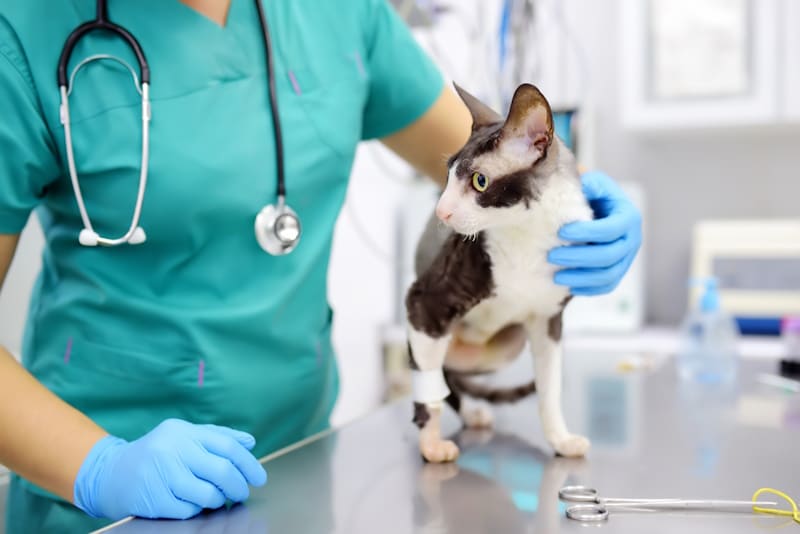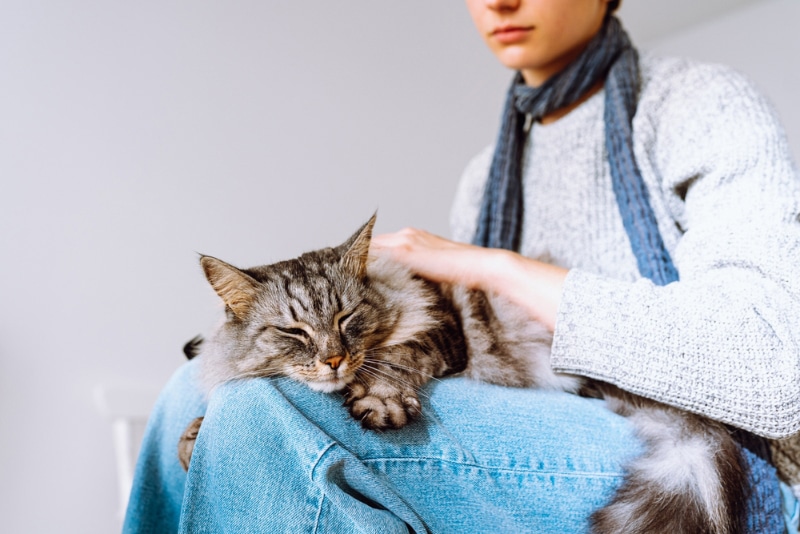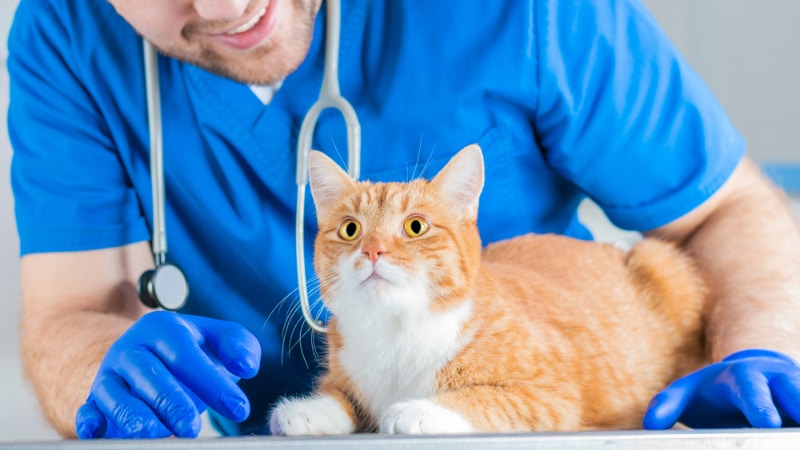[ad_1]
Ehlers-Danlos syndrome in cats is a specific group of disorders affecting the connective tissue. They are typically characterized by loose and stretchy skin that is very fragile. The disorder is caused by a genetic defect which means the cat doesn’t produce collagen correctly. The collagen fibers have an abnormal structure which means the skin is friable and fragile and prone to damage. The skin is weaker, and its structural properties are reduced. The collagen deficiency also affects other tissues in the body, including the heart, blood vessels, and eyes.
Ehlers-Danlos syndrome is diagnosed by measuring the stretch of the skin. Unfortunately, cats that are severely affected generally do not survive. Some cats with milder cases can live for longer although they are at high risk of skin injuries and constant management of wounds is required.

What Is Ehlers-Danlos Syndrome?
Ehlers-Danlos syndrome (also called Feline cutaneous asthenia) is a specific group of disorders affecting the connective tissue. It is characterized by a deficiency in collagen and an abnormality in the structure of the collagen. Collagen is responsible for giving strength and elasticity to the ligaments and the skin as well as other important parts in the body. Collagen provides structural support to the extracellular space of the connective tissues. It is rigid and also resists stretching so it forms an ideal matrix for ligaments, tendons, bones, and skin.
Normal collagen allows for some stretching of the tissue, but it also resists overstretching and allows for the tissue to return to its original shape. In Ehlers-Danlos syndrome, one of the collagen-producing enzymes called Procollagen-peptidase, has a genetic defect so it produces collagen with an abnormal structure. This is what causes weakened skin and makes it loose, stretchy, and easily damaged.
Ehlers-Danlos syndrome is one of a number of hereditary disorders that have the classic clinical signs of droopy, stretchy skin. The genetic mutation that causes it gets passed down from parent cat to kitten. Interestingly the condition can’t be identified by skin or other tissue samples. Diagnosis is made by observation of the stretch present in the skin.

What Are the Signs of Ehlers-Danlos Syndrome in Cats?
Signs of Ehlers-Danlos syndrome are usually seen from 8 weeks old. The first signs owners notice are skin wounds that appear through normal rough and tumble between litter mates. Wounds heal quickly but then leave substantial scars.
Typical signs include:
- Sagging skin
- Presence of redundant folds of skin
- Delicate skin prone to damage
- Loss of elasticity of the skin
- Wide wounds
- Swelling around elbows
- Laxity of the joints
- Bruises/hematoma under the skin
As well as signs relating to the skin, there can be clinical signs due to the lack of collagen internally as well. Sometimes internal bleeding can occur resulting from ruptured internal structures. Cats can also be more prone to infections due to open skin wounds. This condition is more commonly seen in Himalayans, Domestic Shorthairs, and Domestic Longhairs.
What Are the Causes of Ehlers-Danlos Syndrome?
The cause of this condition is a genetic mutation. It can be passed from parent to kitten. The disease can be passed from both parents and be dominant, or just one parent and be recessive. In the dominant form, usually, both parents are carriers, so they don’t show any clinical signs themselves, but they pass on the genes.
In the recessive form, one of the parents can be a carrier with no clinical signs present. If an affected animal has been identified, it is recommended that the parents of the individual and also the siblings are not bred.

Diagnosis of Ehlers-Danlos Syndrome in Cats
It can be difficult to diagnose the disease in cats. Your vet will first carry out a thorough examination of your cat. Your vet will assess the condition of the skin and how stretchy and friable the skin is. They will assess the joints and general condition of the cat and check if they are painful in any areas.
The skin is stretched as far as it will go with the cat still being comfortable, and the skin is then measured. They use this figure to calculate the Skin Extensibility Index. This is the amount the skin has stretched by, divided by the length of the cat from their skull to their tail base. This number that is calculated allows your vet to assess the severity of the condition.
How Do I Care for a PET with Ehlers-Danlos Syndrome?
Sadly, there is no cure for this condition, and it also carries a poor prognosis. Cats generally have a very poor quality of life, and they can be in a considerable amount of pain. They often have many wounds that need suturing and require treatment such as antibiotics if they become infected. It is important to have your cat neutered, firstly so that they don’t pass the disease onto their offspring, and also so that they do not get any injuries from mating.
Housing cats with the condition along with other cats or young children increases the risks of injuries to the fragile skin. The cat’s environment needs to be adapted to reduce the risk of injuries on sharp edges or rough surfaces. The cat’s bedding needs to be chosen carefully to ensure it is padded enough so as to not cause trauma when the cat sleeps on it. It can be very difficult to handle your cat and any sort of restraint required, at the vet, for example, can prove to be very challenging.
Close attention must be paid to any skin conditions that may develop that would cause your cat to scratch excessively such as dermatitis or flea infestation. Management can become challenging, and many owners opt for euthanasia as this is often the kindest option.


Frequently Asked Questions
Can you tell if a cat is likely to have the syndrome?
There is no genetic test available to determine if your cat has this disorder. This makes identifying which cats are affected and which aren’t very difficult. As well as this, the severity of the condition can vary greatly. Some cats may only have very mild clinical signs so it will be harder to spot, but they will still pass on the genetic defect.
What is the prognosis for Ehlers-Danlos Syndrome?
Cats that are affected with the syndrome generally have a poor prognosis. It is a debilitating disease, and their quality of life is severely affected. Collagen plays an important role in lots of different areas in the body and the lack of it causes multiple issues.
What can you do to help a cat with Ehlers-Danlos Syndrome?
Despite the fact this is a debilitating condition, there are a few things you can do around the home to make your cat more comfortable and less likely to injure themselves. Get your cat neutered as they should not be bred from, but also because they may become injured when mating. Other cats and small children should be kept away from the affected cat. This is to attempt to minimize the risk of injuries to the skin from playing and petting.
Ensure there is nothing in your home that your cat can injure themselves on such as sharp pointed objects or rough surfaces. Keep your cat indoors as they are much more likely to injure themselves outside. Ensure they are up to date with parasite treatment to prevent things like flea infestations.

Conclusion
Ehlers-Danlos syndrome is a rare condition affecting cats. It varies in severity and can be extremely debilitating. It is characterized by droopy, stretchy loose skin that is fragile and easily injured.
There is no cure for this disease. Changes can be made in the home environment to make injury less likely but there are no treatment options. Many owners opt for euthanasia as the quality of life is compromised and the cat suffers greatly with this condition.
Featured Image Credit: Andy Gin, Shutterstock
[ad_2]
Source link
